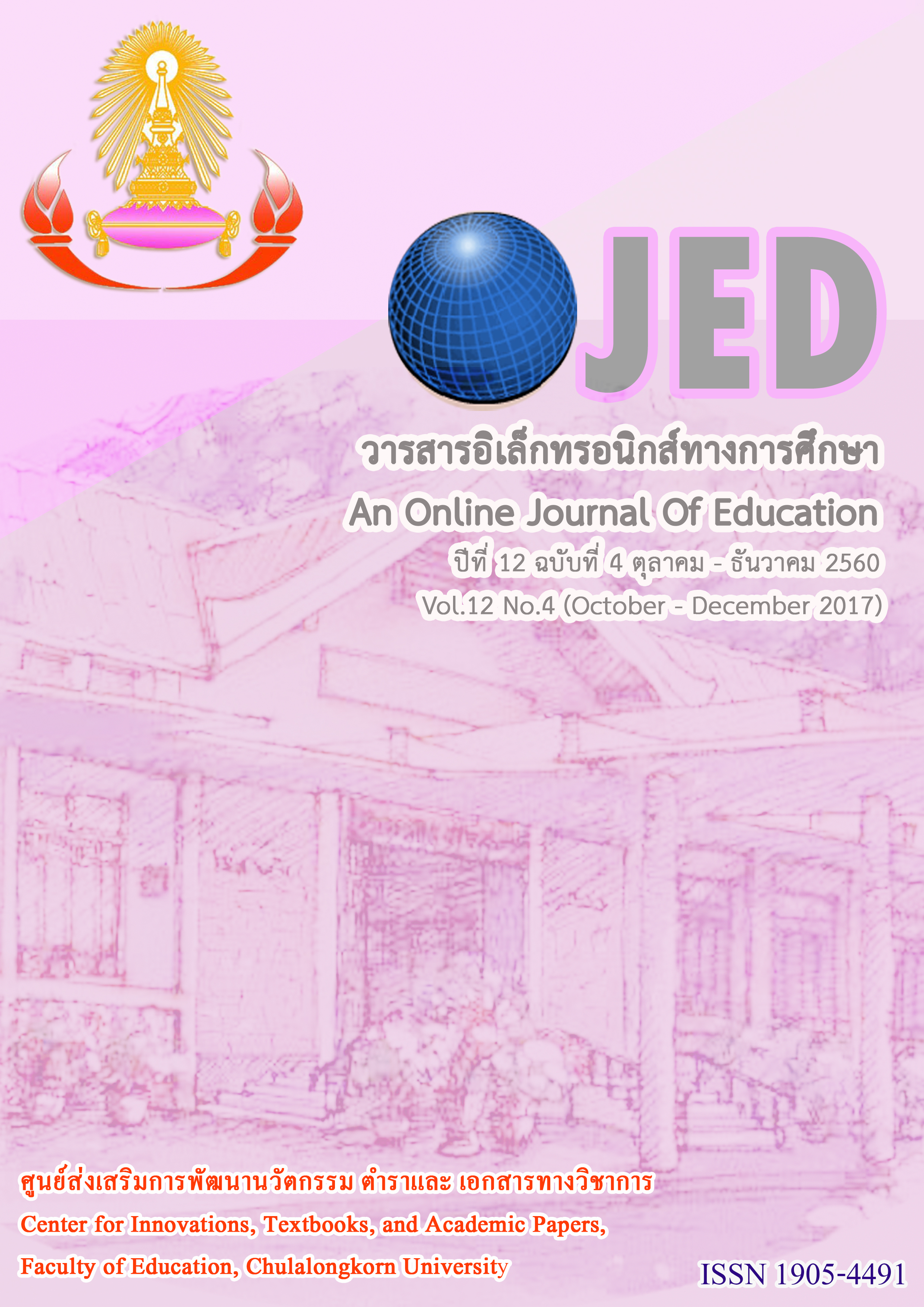การพัฒนาโมเดลทำนายแผนการเรียนในการศึกษาต่อระดับมัธยมศึกษาตอนปลาย
Keywords:
การวิเคราะห์จำแนกกลุ่ม, ซัพพอร์ตเวกเตอร์แมชชีน, ต้นไม้ตัดสินใจ, DISCRIMINANT ANALYSIS, SUPPORT VECTOR MACHINE, DECISION TREEAbstract
การวิจัยครั้งนี้มีวัตถุประสงค์ 2 ประการ คือ (1) เพื่อศึกษาปัจจัยที่สามารถทำนายแผนการเรียนของนักเรียนในการศึกษาต่อระดับม.ปลาย และ (2) เพื่อเปรียบเทียบประสิทธิภาพของโมเดลทำนายแผนการเรียนที่ได้จากการวิเคราะห์โดยใช้เทคนิคการวิเคราะห์จำแนกกลุ่ม ซัพพอร์ตเวกเตอร์แมชชีน และต้นไม้ตัดสินใจ ประชากรที่ใช้ในการวิจัยครั้งนี้คือ นักเรียนชั้นม.6 ปีการศึกษา 2559 ในโรงเรียนสังกัดสำนักงานคณะกรรมการการศึกษาขั้นพื้นฐาน จำนวน 374,749 คน โดยมีตัวอย่างนักเรียนที่ได้จากการสุ่มแบบหลายขั้นตอน จำนวน 1,259 คน ใช้โปรแกรมคอมพิวเตอร์สำเร็จรูปสำหรับการวิเคราะห์สถิติพื้นฐานและการวิเคราะห์จำแนกกลุ่ม และใช้โปรแกรม Rapid Miner Studio สำหรับการวิเคราะห์ซัพพอร์ตเวกเตอร์แมชชีนและต้นไม้ตัดสินใจ ผลการวิจัยสรุปว่าการวิเคราะห์ซัพพอร์ตเวกเตอร์แมชชีนจะมีประสิทธิภาพในการจำแนกข้อมูลได้ดีที่สุดในทุกโมเดล รองลงมาคือการวิเคราะห์ต้นไม้ตัดสินใจ และการวิเคราะห์จำแนกกลุ่ม ตามลำดับ โดยโมเดลที่มีประสิทธิภาพในการทำนายแผนการเรียนได้ดีที่สุดคือโมเดล S-M-L ซึ่งเป็นโมเดลที่ใช้ทำนายแผนการเรียนเฉพาะ 3 แผนการเรียน ได้แก่ แผนการเรียนวิทย์-คณิต, ศิลป์-คณิต และศิลป์-ภาษา โดยมีประสิทธิภาพของการทำนายด้วยซัพพอร์ตเวกเตอร์แมชชีนได้ถูกต้องคิดเป็นร้อยละ 82.26 และจากการวิเคราะห์ตัวแปรทำนายที่ใช้ในโมเดล S-M-L ด้วยซัพพอร์ตเวกเตอร์แมชชีน สามารถเรียงระดับความสำคัญของตัวแปรทำนายได้ดังนี้ คือ ผลการเรียนเฉลี่ยของกลุ่มสาระฯ คณิตศาสตร์ ม.ต้น, การรับรู้ความสามารถของตนเอง, การได้รับคำแนะนำจากครูแนะแนวในโรงเรียน, โอกาสในการประกอบอาชีพ, ผลการเรียนเฉลี่ยของกลุ่มสาระฯ ภาษาไทย ม.ต้น, การสนับสนุนจากครอบครัว, ผลการเรียนเฉลี่ยของกลุ่มสาระฯ ภาษาต่างประเทศ ม.ต้น, ผลการเรียนเฉลี่ยของกลุ่มสาระฯ วิทยาศาสตร์ ม.ต้น และเพศ ตามลำดับ
The purposes of this research were (1) to study the factors that can predict the future study plans of upper secondary school levels; and (2) to compare the effectiveness of the prediction model for future study plans from discriminant analysis, the support vector machine and a decision tree. The population of the research included 374,749 Mathayom 6 students of the 2016 academic year studying in the schools under the Office of the Basic Education Commission, and 1,259 students were selected by using multi-stage sampling. Statistical software was used for descriptive statistics and discriminant analysis. Additionally, Rapid Miner Studio was also used to analyze the support vector machine and decision tree. The result of the research could conclude that the analysis of the support vector machine was the most effective in data classification followed by the decision tree and discriminant analysis, respectively. The S-M-L model, which could predict three suitable study plans including Sci-Math, Eng-Math and Eng-Foreign Language study plan, had the most effectiveness in predicting the study plan. The S-M-L model with support vector machine had an efficiency at 82.26%. Furthermore, it showed that the variable factors rated according to significant sequence were lower secondary school level GPA in Mathematics followed by self-evaluation, advice from school counselors, occupational opportunity, GPA in Thai, family support, GPA in English, GPA in Science, and gender, respectively.




